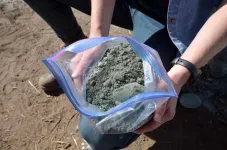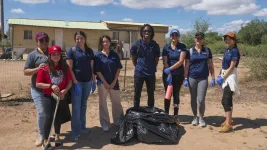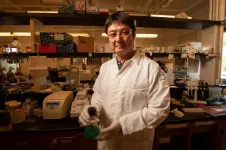(Press-News.org) Researchers have identified buried kimberlite, the rocky home of diamonds, by testing the DNA of microbes in the surface soil.
These ‘biological fingerprints’ can reveal what minerals are buried tens of metres below the earth’s surface without having to drill. The researchers believe it is the first use of modern DNA sequencing of microbial communities in the search for buried minerals.
The research published this week in Nature Communications Earth and Environment represents a new tool for mineral exploration, where a full toolbox could save prospectors time and a lot of money, says co-author Bianca Iulianella Phillips, a doctoral candidate at UBC’s department of earth, ocean and atmospheric sciences (EOAS).
The technique adds to the relatively limited number of tools that help find buried ore, including initial scans of the ground and analysis of elements in the overlying rock.
“This technique was born from a necessity to see through the earth with greater sensitivity and resolution, and it has the potential to be used where other techniques aren’t working,” said Phillips.
When ore interacts with soil, it changes the communities of microbes in the soil. The researchers tested this in the lab, introducing kimberlite to soil microbes and watching how they changed in number and species.
“We took those changed communities of microbes as indicators for the presence of ore materials, or biological fingerprints in the soil of buried mineral deposits,” said Phillips.
Using these ‘indicator’ microbes and their DNA sequences, the team tested the surface soil at an exploration site in the Northwest Territories where kimberlite had previously been confirmed through drilling. They found 59 of the 65 indicators were present in the soil, with 19 present in high numbers directly above the buried ore. They also identified new indicator microbes to add to their set.
Using this set, they tested the surface soil at a second site in the Northwest Territories where they suspected kimberlite was present, and precisely located the topological outline and location of kimberlite buried tens of metres beneath the earth’s surface. This showed that indicators from one site could predict the location at another site. In future, exploration teams could build up a database of indicator species and test an unknown site to find out if kimberlite deposits are buried beneath the soil.
The researchers evaluated their technique against another technique known as geochemical analysis, which involves testing elements in the soil to identify the minerals beneath. The microbes were more precise when it came to identifying the location of buried ore.
“Microbes are better geochemists than us, and there are thousands of them,” said lead author Dr. Rachel Simister, who conducted the work as a postdoctoral researcher in the UBC department of microbiology and immunology (M&I). “You might run out of elements to sample, but you’ll never run out of microbes.”
The technique, born from work by a team including Phillips, Dr. Simister, Dr. Sean Crowe and the late professor Peter Winterburn, could catalyze the discovery of new kimberlite deposits. These rocks are known not only as potential stores of diamonds, but also for their ability to capture and store atmospheric carbon.
The technique has potential application across other metallic deposits. The team’s ongoing research shows similar results for identifying porphyry copper deposits.
“You could use this technique to find minerals to fuel a green economy,” said senior author Dr. Crowe, EOAS and M&I professor and Canada Research Chair in Geomicrobiology. “Copper is the most important critical element that we’ll need more of going forward.”
Dr. Crowe, along with Dr. Simister and co-author Dr. Craig Hart, co-owns spin-off company Discovery Genomics which provides these sequencing services to the mineral resource sector.
“This is exciting because it's part of a growing recognition of the potential for using microbes at every stage of mining, from finding the minerals, to processing them, to returning sites to their natural states.” said Dr. Crowe. “Currently, microbial DNA sequencing requires specific expertise and is comparable in cost to other mineral exploration techniques, but this could change with industry adoption.”
END
Biological fingerprints in soil show where diamond-containing ore is buried
DNA sequencing technique can also help source minerals that are key to the green-energy transition
2023-10-24
ELSE PRESS RELEASES FROM THIS DATE:
Adding crushed rock to farmland pulls carbon out of the air
2023-10-24
Adding crushed volcanic rock to cropland could play a key role in removing carbon from the air. In a field study, scientists at the University of California, Davis, and Cornell University found the technology stored carbon in the soil even during an extreme drought in California. The study was published in the journal Environmental Research Communications.
Rain captures carbon dioxide from the air as it falls and reacts with volcanic rock to lock up carbon. The process, called rock weathering, can take millions of years ...
Neuroscientist Huda Akil, Ph.D., wins National Medal of Science
2023-10-24
She has explored the brain’s secrets for more than 50 years, delving deep into the genes, proteins and cells that help govern our emotions and moods, and our responses to pleasure and pain.
And today, Huda Akil, Ph.D., received the nation’s highest scientific honor – the National Medal of Science -- for those contributions and their impact on humankind’s understanding of depression, anxiety, addiction and more.
Akil, a neuroscientist at the University of Michigan Medical School and Michigan Neuroscience Institute, and her fellow awardees were honored at the White House in a ceremony ...
AZ-HOPE receives $3.2M HRSA grant to support future health care professionals
2023-10-24
Arizona Health Opportunities Pathways to Excellence, a program of the University of Arizona Health Sciences Office of Equity, Diversity and Inclusion, received a $3.2 million grant from the U.S. Department of Health and Human Services to help students from disadvantaged backgrounds achieve their dreams of becoming health care professionals.
Arizona Health Opportunities Pathways to Excellence, or AZ-HOPE, is a collaboration between academic and community partners to support students’ educational endeavors and help them overcome barriers on the pathway ...
Cleveland Clinic-led trial finds that atrial fibrillation patients undergoing TAVR and Watchman™ procedures together have similar outcomes to using blood thinners after TAVR
2023-10-24
Tuesday, October 24, 2023, Cleveland: Findings from a trial led by Cleveland Clinic show that patients with atrial fibrillation undergoing a transcatheter aortic valve replacement (TAVR) at the same time as a left atrial appendage occlusion (LAAO) procedure using the Watchman™ device had similar outcomes when compared to patients getting TAVR in addition to medical therapy or blood thinners.
Results from the “Safety and Efficacy of Left Atrial Appendage Occlusion at the Time of Transcatheter Aortic Valve Replacement — ...
Upadacitinib in active Crohn’s disease: no added benefit proven due to lack of comparative studies
2023-10-24
Like several immunosuppressive biologics, the JAK inhibitor upadacitinib is also approved for the treatment of Crohn's disease. Commissioned by the Federal Joint Committee (G-BA), the Institute for Quality and Efficiency in Health Care (IQWiG) has now investigated in an early benefit assessment whether the drug offers an added benefit versus the appropriate comparator therapy to patients with moderate to severe active Crohn's disease who have had an inadequate response, lost response or are intolerant to conventional therapy or a biologic agent.
Therefore, an added benefit is not proven due to a lack of suitable study data. The ...
Adapting to climate change: Individuals take action while governments plan
2023-10-24
UNIVERSITY PARK, Pa. — While governments may take the lead in planning and financing climate change adaptation measures, such as incentivizing green infrastructure, individuals currently are most often the ones implementing actions to adapt to climate change, according to new research. The analysis, conducted by an international consortium of researchers from 20 institutions, including Penn State, in 12 countries, published in Nature Climate Change.
“The evidence suggests that individuals and households are the primary adaptation actors — the ones actually implementing ways to ...
New clues to early development of schizophrenia
2023-10-24
Philadelphia, October 24, 2023 – Schizophrenia is a severe neuropsychiatric disease that remains poorly understood and treated. Schizophrenia onset is typically in adolescence or early adulthood, but its underlying causes are thought to involve neurodevelopmental abnormalities. Because human prenatal and postnatal brain tissue is exceedingly difficult to procure and therefore study, researchers have had limited opportunities to identify early disease mechanisms, especially during the critical prenatal period. Now, a pair of studies that appear in Biological Psychiatry, ...
What an animated taco reveals about curiosity and patience
2023-10-24
DURHAM, N.C. -- Curiosity paradoxically increases people’s patience for an answer, while simultaneously making them more eager to hear it, finds a new study by Duke neuroscientists.
The research might help teachers and students alike by describing a side of curiosity that encourages us to stay engaged instead of seeking immediate relief.
Die-hard fans of the Hulu show, "The Bear" are left on the edge of their seats each Sunday, wondering what's going to happen in the scrappy Chicago hotdog shop next week. But the new study from Duke helps explain why viewers may choose to avoid spoilers ...
UC Davis, Mars researchers discover scalable production technique for low-calorie sugar substitute
2023-10-24
Scientists at the University of California, Davis, in partnership with the Mars Advanced Research Institute, have announced a significant breakthrough in the production of low-calorie sugar substitutes, such as allulose. This discovery could help address one of the primary obstacles to the widespread adoption of these alternatives: production costs.
Allulose, also known as D-psicose, is a naturally occurring rare sugar that provides a viable alternative to sucrose (table sugar). It has a similar taste, texture and functionality, making it an attractive option for those seeking to reduce their sugar intake. By activating a natural process in a microorganism, researchers have developed ...
Bitcoin mining has “very worrying” impacts on land and water, not only carbon, UN-led study reveals
2023-10-24
American Geophysical Union
24 October 2023
AGU Release No. 23-39
For Immediate Release
This press release and accompanying multimedia are available online at: https://news.agu.org/press-release/bitcoin-mining-has-very-worrying-impacts-on-land-and-water-not-only-carbon/
AGU press contact:
Rebecca Dzombak, news@agu.org (UTC-4 hours)
Contact information for the researchers:
Kaveh Madani, United Nations University, madani@unu.edu (UTC-4 hours)
By the numbers, global bitcoin mining in 2020-2021:
Used 173 terawatt ...
LAST 30 PRESS RELEASES:
Numbers in our sights affect how we perceive space
SIMJ announces global collaborative book project in commemoration of its 75th anniversary
Air pollution exposure and birth weight
Obstructive sleep apnea risk and mental health conditions among older adults
How talking slows eye movements behind the wheel
The Ceramic Society of Japan’s Oxoate Ceramics Research Association launches new international book project
Heart-brain connection: international study reveals the role of the vagus nerve in keeping the heart young
Researchers identify Rb1 as a predictive biomarker for a new therapeutic strategy in some breast cancers
Survey reveals ethical gaps slowing AI adoption in pediatric surgery
Stimulant ADHD medications work differently than thought
AI overestimates how smart people are, according to HSE economists
HSE researchers create genome-wide map of quadruplexes
Scientists boost cell "powerhouses" to burn more calories
Automatic label checking: The missing step in making reliable medical AI
Low daily alcohol intake linked to 50% heightened mouth cancer risk in India
American Meteorological Society announces Rick Spinrad as 2026 President-Elect
Biomass-based carbon capture spotlighted in newly released global climate webinar recording
Illuminating invisible nano pollutants: advanced bioimaging tracks the full journey of emerging nanoscale contaminants in living systems
How does age affect recovery from spinal cord injury?
Novel AI tool offers prognosis for patients with head and neck cancer
Fathers’ microplastic exposure tied to their children’s metabolic problems
Research validates laboratory model for studying high-grade serous ovarian cancer
SIR 2026 delivers transformative breakthroughs in minimally invasive medicine to improve patient care
Stem Cell Reports most downloaded papers of 2025 highlight the breadth and impact of stem cell research
Oxford-led study estimates NHS spends around 3% of its primary and secondary care budget on the health impacts of heat and cold in England
A researcher’s long quest leads to a smart composite breakthrough
Urban wild bees act as “microbial sensors” of city health.
New study finds where you live affects recovery after a hip fracture
Forecasting the impact of fully automated vehicle adoption on US road traffic injuries
Alcohol-related hospitalizations from 2016 to 2022
[Press-News.org] Biological fingerprints in soil show where diamond-containing ore is buriedDNA sequencing technique can also help source minerals that are key to the green-energy transition




